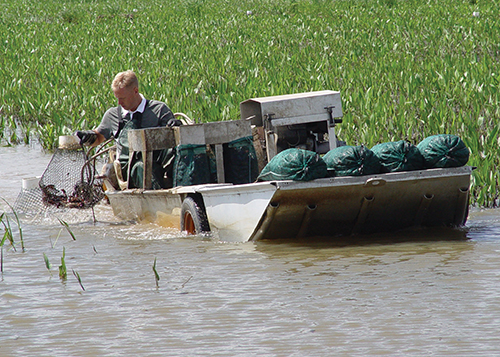
Airport Working Hard to Secure Area’s Economic Future
June 13, 2018
How to Succeed in Warm Dry Weather?
June 13, 2018By CASEY GISCLAIR
The winter of 2017-18 was cold – one of the chilliest in recent memory in the Houma-Thibodaux area with several low temperatures in the teens and a handful of days with snow and/or a wintry mix.
Locals loved it. Social media buzzed with photos of enjoying the cold. The day it snowed was one of the busiest days for web traffic in the history of The Times’ website and our photo gallery of the snow drew tens of thousands of views around the country.
But while locals rejoiced, seafood lovers sulked because they knew that bitter cold meant crawfish season was going to be delayed.
It was, though only brief, and now experts in the field are saying that the season ended up being a successful one – even through the adversity. Crawfish experts say that the year’s harvest was on par with projections, even after so many early-season days of bitter cold.
Locally in early June, mudbugs were still available throughout the Houma-Thibodaux area at prices which ranged from $2.00 and $2.50 per pound live and, of course, a greater price if boiled.
The supply will taper off in the coming weeks as the season ends, but that there is still supply this late in the year is a testament to how well the year recovered.
“It’s been very good,” said Cut Off native Kyle Guidry, who used to fish for mudbugs, but now is an avid buyer for boils he and his friends have at a hunting camp in Mississippi. “The price was high early in the season, but I think a lot of us are surprised that it bounced back as strongly as it did. It ended up, all things considered, being a pretty good year.”
Mother Nature did her best to limit the catch. Crawfish are cold-blooded animals, which means that they lie dormant when in habitats which their bodies deem are too cold.
For crawfish, water temperatures below 55-60 degrees mark that threshold. When waters are that cold, crawfish don’t move, which also means that they don’t hunt.
For those in the seafood industry, this also means that they’re not growing and are unable to be caught and sold to retailers.
If temperatures get dangerously cold and/or frozen for long periods of time, the crawfish may even die. This was one of the early-winter concerns this past year because water temperatures are colder in shallow depths and the early winter was chilly, but dry. Experts say what likely helped save the harvest was the precipitation, which allowed the crustaceans to burrow in deeper waters in the basins.
“The rains and snows saved us,” Guidry said. “If not for that, there would have been shallow water, colder temperatures and some of the harvest would have likely been lost.”
On warm winter years, crawfish can start to grow and fill the local market early in the calendar year. With our cold winter, the season was delayed until spring.
“The cold weather did not reduce the population but it did keep crawfish from feeding and reaching the market size,” said Craig Gautreaux, a correspondent with the LSU Ag Center.
“The crawfish just did not grow in December and January,” added Mark Shirley, a Sea Grant and LSU Ag Center Aquaculture Agent. “So they missed three or four or maybe five molts.”
But after the coldest spat, temperatures quickly rose back to normal and above-normal levels, which quickly enabled the market to settle.
In early-April, crawfish flooded the market in medium sizes. Soon after, the price was able to drop and more local restaurants were able to offer the food in abundance.
Allen McLain Jr., a crawfish producer said that there was a lot of concern during the cold spat, but added that the harvest was resilient and mostly unharmed – even if a little slower to grow.
“We’ve been pretty fortunate,” McLain said in late-April when the season was starting to get active. “Our catch has been pretty consistent. With the warmer weather that we’ve had the past couple weeks, the catch has increased and the size is getting really, very good.”
So with the peak of the season now over and only a limited amount of time left to eat the prized Louisiana treasure, locals said they’re already turning an eye to 2019.
Guidry said he’s rooting for a warm summer, then a muggy winter because both of those things will raise water temperatures. The higher water temperatures are when winter begins, the more cold crawfish can withstand when temperatures begin to drop in the season change.
Experts also say that they’re not necessarily opposed to cold weather, but problems arise when it’s bitter cold for an extended period of time. This is when water temperatures drop the most and struggle to creep back up.
“If it’s crazy Louisiana weather where it’s 30 degrees one day, but 70 degrees two days later, that doesn’t hurt us,” Guidry said. “What we don’t want is a week of really cold weather or a month where there are 20 days that are colder than normal. But those are extremes. If it’s normal, the crawfish can survive and grow. They’re resilient animals.” •










